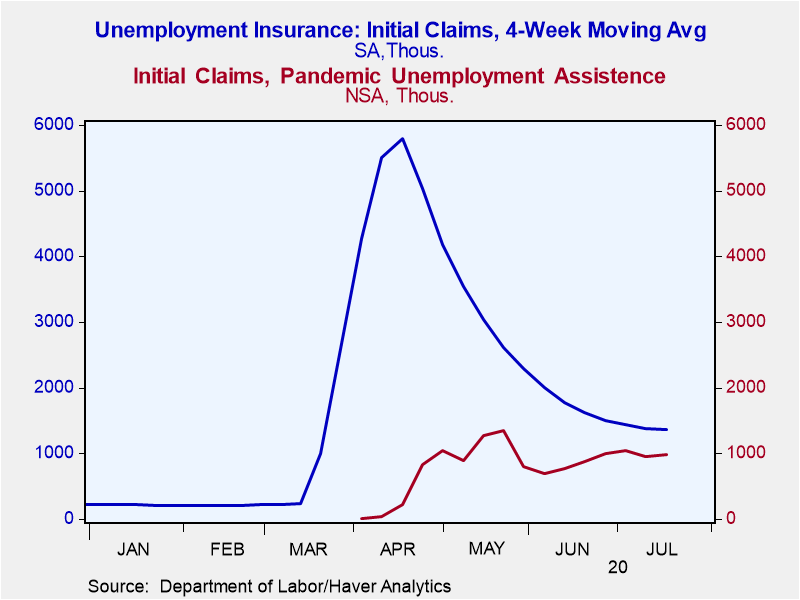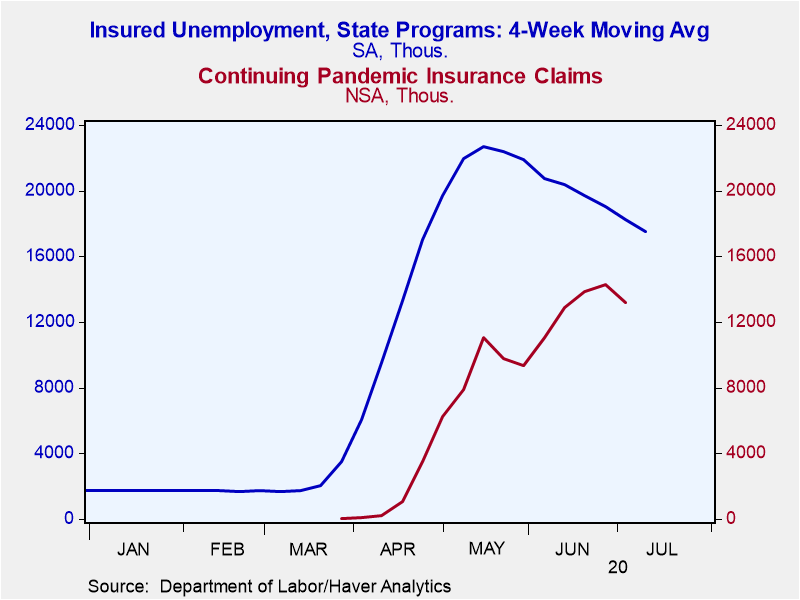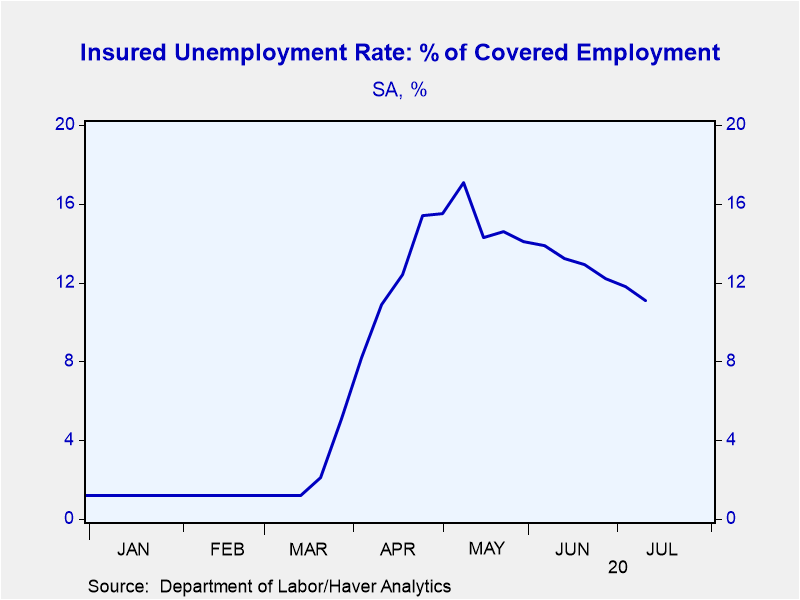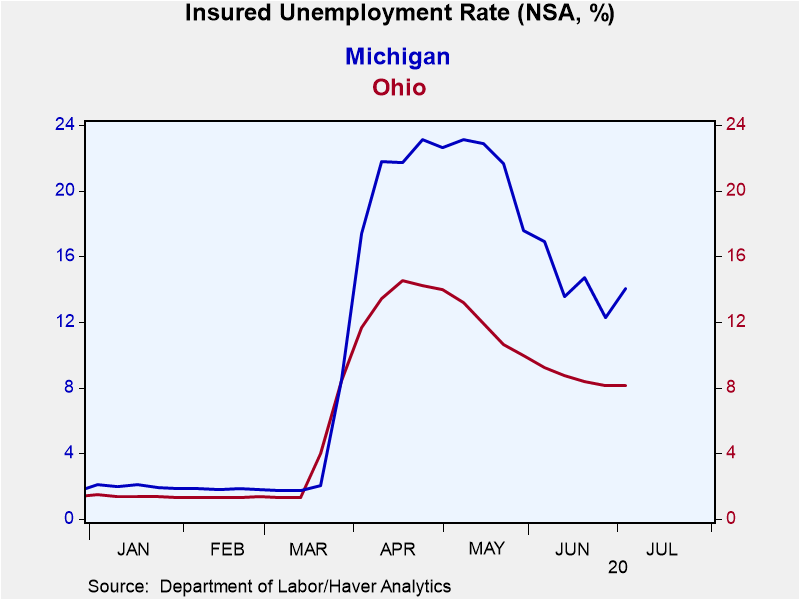 Global| Jul 23 2020
Global| Jul 23 2020State & Pandemic Assistance Unemployment Insurance Claims Increase Unexpectedly
by:Tom Moeller
|in:Economy in Brief
Summary
• State initial jobless claims rise for the first time since March, as job reopenings are rolled back. • New filings for Federal Pandemic Unemployment Assistance rise. • Continuing claims for state programs slip. • The insured [...]
• State initial jobless claims rise for the first time since March, as job reopenings are rolled back.
• New filings for Federal Pandemic Unemployment Assistance rise.
• Continuing claims for state programs slip.
• The insured unemployment rate declines.
State initial jobless claims for unemployment insurance increased to 1.416 million during the week ended July 18 from 1.307 million in the prior week, revised from 1.300 million. The Action Economics Forecast Survey anticipated 1.285 million claims. The four-week moving average of initial claims eased to 1.360 million, the lowest level since April.
The latest figure covers the survey week for July nonfarm payrolls and claims were 8.1% below the June period. During the last ten years there has been a 70% correlation between the level of initial claims and the m/m change in payroll employment.
Initial claims for the federal Pandemic Unemployment Assistance (PUA) program, which covers individuals such as the self-employed who are not qualified for regular/state unemployment insurance, increased to 974,999 in the week ended July 18 from 955,272 in the prior week, revised from 928,488. PUA claims peaked at 1.348 million in the week ending May 23. Data for this and other federal programs are not seasonally adjusted.
Continuing claims for unemployment insurance declined to 16.197 million in the week ended July 11 from 17.304 million in the prior week, revised from 17.338 million. Continuing PUA claims, which are lagged an additional week, fell to 1.318 million from 1.428 million, revised from 14.283 million. Pandemic Emergency Unemployment Compensation claims increased to 940,113 in the week ending July 3. This program covers people who were unemployed before COVID but exhausted their state benefits and are not eligible to receive an additional 13 weeks of unemployment insurance, up to a total of 39 weeks. Including the latest data available, which is lagged one additional week, the number of continuing claims eased to 31.8 million, or 19.9% of the labor force.
The state insured rate of unemployment, which does not include federal programs, declined to 11.1% and remained below a mid-May peak of 17.1%. Individual state rates varied greatly. South Dakota at 4.5% was down from a May peak of 6.03%. Nevada was highest at 21.3%, down from a June peak of 26.75%. New York stood at 16.1%, below last month's peak of 19.92%, California at 16.9% was down from 20.57% and New Jersey stood at 12.2% versus 17.8% early in May. The insured unemployment rate in Michigan of 14.1% compared to a late-April peak of 23.14% and Ohio, at 8.1%, was down from 14.54% in mid-April. The state rates are not seasonally adjusted.
Data on weekly unemployment claims going back to 1967 are contained in Haver's WEEKLY database, and they are summarized monthly in USECON. Data for individual states are in REGIONW. The expectations figure is from the Action Economics Forecast Survey, carried in the AS1REPNA database.
| Unemployment Insurance (SA, 000s) | 07/18/20 | 07/11/20 | 07/04/20 | Y/Y % | 2019 | 2018 | 2017 |
|---|---|---|---|---|---|---|---|
| Initial Claims | 1,416 | 1,307 | 1,310 | 571 | 218 | 221 | 244 |
| 4-week Average | 1,360 | 1,377 | 1,435 | -- | -- | -- | -- |
| Initial Claims Pandemic Unemployment Assistance (NSA) | 975 | 955 | 1,046 | -- | -- | -- | -- |
| Continuing Claims | -- | 16,197 | 17,304 | 863 | 1,701 | 1,756 | 1,961 |
| 4-week Average | -- | 17,505 | 18,262 | -- | -- | -- | -- |
| Continuing Claims Pandemic Unemployment Assistance (NSA) | -- | -- | 1,318 | -- | -- | -- | -- |
| Insured Unemployment Rate (%) | -- | 11.1 | 11.8 |
1.2 |
1.2 | 1.2 | 1.4 |
Tom Moeller
AuthorMore in Author Profile »Prior to joining Haver Analytics in 2000, Mr. Moeller worked as the Economist at Chancellor Capital Management from 1985 to 1999. There, he developed comprehensive economic forecasts and interpreted economic data for equity and fixed income portfolio managers. Also at Chancellor, Mr. Moeller worked as an equity analyst and was responsible for researching and rating companies in the economically sensitive automobile and housing industries for investment in Chancellor’s equity portfolio. Prior to joining Chancellor, Mr. Moeller was an Economist at Citibank from 1979 to 1984. He also analyzed pricing behavior in the metals industry for the Council on Wage and Price Stability in Washington, D.C. In 1999, Mr. Moeller received the award for most accurate forecast from the Forecasters' Club of New York. From 1990 to 1992 he was President of the New York Association for Business Economists. Mr. Moeller earned an M.B.A. in Finance from Fordham University, where he graduated in 1987. He holds a Bachelor of Arts in Economics from George Washington University.










